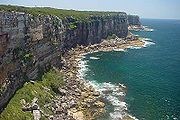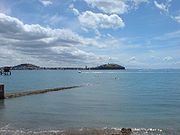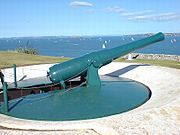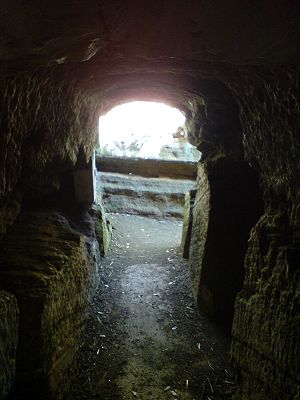
North Head, New Zealand
Encyclopedia



New Zealand
New Zealand is an island country in the south-western Pacific Ocean comprising two main landmasses and numerous smaller islands. The country is situated some east of Australia across the Tasman Sea, and roughly south of the Pacific island nations of New Caledonia, Fiji, and Tonga...
, in the suburb of Devonport
Devonport, New Zealand
Devonport is a harbourside suburb of Auckland, New Zealand. It is located on the North Shore, at the southern end of a peninsula that runs southeast from near Lake Pupuke in Takapuna, forming the northern side of the Waitemata Harbour...
at the east end of the Waitemata Harbour
Waitemata Harbour
The quite famous Waitemata Harbour is the main access by sea to Auckland, New Zealand. For this reason it is often referred to as Auckland Harbour, despite the fact that it is only one of two harbours surrounding the city, and is crossed by the Auckland Harbour Bridge. The Waitemata forms the north...
(Auckland
Auckland
The Auckland metropolitan area , in the North Island of New Zealand, is the largest and most populous urban area in the country with residents, percent of the country's population. Auckland also has the largest Polynesian population of any city in the world...
's harbour).
It is a public reserve (part of the Hauraki Gulf Maritime Park) known for its sweeping views over the harbour and the Hauraki Gulf
Hauraki Gulf
The Hauraki Gulf is a coastal feature of the North Island of New Zealand. It has a total area of 4000 km², and lies between the Auckland Region, the Hauraki Plains, the Coromandel Peninsula and Great Barrier Island...
. During the last century it was mainly used by the military for coastal defense installation, which left a network of accessible old bunkers and tunnels as its legacy, forming part of the attraction.
Māori usage
The original scoriaScoria
Scoria is a volcanic rock containing many holes or vesicles. It is most generally dark in color , and basaltic or andesitic in composition. Scoria is relatively low in mass as a result of its numerous macroscopic ellipsoidal vesicles, but in contrast to pumice, all scoria has a specific gravity...
cone has been substantially altered, first by marine erosion and later by the various generations of people who have occupied the headland. It was first used by Māori, one of whose ancestral waka
Waka (canoe)
Waka are Māori watercraft, usually canoes ranging in size from small, unornamented canoes used for fishing and river travel, to large decorated war canoes up to long...
canoes was reputed to have put ashore close by. Some early photographs of the area show that they used to work gardens on the hill's lower slopes, though the pā
Pa (Maori)
The word pā can refer to any Māori village or settlement, but in traditional use it referred to hillforts fortified with palisades and defensive terraces and also to fortified villages. They first came into being about 1450. They are located mainly in the North Island north of lake Taupo...
fortifications of other cones in the area seem absent. European visitors during the 1850s have also described a settlement at the foot of the hill with gardens and racks for the drying of fish.
Military usage

New Zealand Army
The New Zealand Army , is the land component of the New Zealand Defence Force and comprises around 4,500 Regular Force personnel, 2,000 Territorial Force personnel and 500 civilians. Formerly the New Zealand Military Forces, the current name was adopted around 1946...
. In 1885, this then became reality, with the Russian scare
Panjdeh Incident
The Panjdeh Incident or Panjdeh Scare was a battle that occurred in 1885 when Russian forces seized Afghan territory south of the Oxus River around an oasis at Panjdeh . The incident created a diplomatic crisis between Russia and Great Britain...
reaching its height and forts being built in various places around Auckland, to deter the anticipated invaders from the far north.
Three large gun batteries were erected: North Battery facing over the Rangitoto Channel, South Battery facing over the inner harbour, and Summit/Cautley Battery on the top of the hill. These first fortifications were hastily constructed, but later expanded and strengthened over 25 years by convict labor of up to 40 prisoners living in a barracks on the hilltop. They added extensive tunnel systems, underground store rooms and various observation post
Observation post
An observation post, temporary or fixed, is a position from which soldiers can watch enemy movements, to warn of approaching soldiers , or to direct artillery fire...
s. The armaments of the fort included 64 pounder Armstrong
William George Armstrong, 1st Baron Armstrong
William George Armstrong, 1st Baron Armstrong CB, FRS was an effective Tyneside industrialist who founded the Armstrong Whitworth manufacturing empire.-Early life:...
disappearing gun
Disappearing gun
A disappearing gun is a type of heavy artillery for which the gun carriage enabled the gun to rotate backwards and down into a pit protected by a wall or a bunker after it was fired...
s, searchlight
Searchlight
A searchlight is an apparatus that combines a bright light source with some form of curved reflector or other optics to project a powerful beam of light of approximately parallel rays in a particular direction, usually constructed so that it can be swiveled about.-Military use:The Royal Navy used...
s and a remote-detonated naval minefield across the inner harbour to Bastion Point
Bastion Point
Bastion Point is a coastal piece of land in Orakei, Auckland, New Zealand, overlooking the Waitemata Harbour. The area has significance in New Zealand history for its role in 1970s Māori protests against forced land alienation by non Māori New Zealanders.-History:The land was occupied by Ngāti...
. None of the armaments were ever used in anger. A four-gun memorial saluting battery of 18 pounder World War I
World War I
World War I , which was predominantly called the World War or the Great War from its occurrence until 1939, and the First World War or World War I thereafter, was a major war centred in Europe that began on 28 July 1914 and lasted until 11 November 1918...
field gun
Field gun
A field gun is an artillery piece. Originally the term referred to smaller guns that could accompany a field army on the march and when in combat could be moved about the battlefield in response to changing circumstances, as to opposed guns installed in a fort, or to siege cannon or mortars which...
s was used, among other occasions to salute Queen Elizabeth II
Elizabeth II of the United Kingdom
Elizabeth II is the constitutional monarch of 16 sovereign states known as the Commonwealth realms: the United Kingdom, Canada, Australia, New Zealand, Jamaica, Barbados, the Bahamas, Grenada, Papua New Guinea, the Solomon Islands, Tuvalu, Saint Lucia, Saint Vincent and the Grenadines, Belize,...
on her visit in 1953.
In the 1930s, part of the fort was modernised, and during World War II
World War II
World War II, or the Second World War , was a global conflict lasting from 1939 to 1945, involving most of the world's nations—including all of the great powers—eventually forming two opposing military alliances: the Allies and the Axis...
, it became the administrative centre of Auckland's coast defenses, with the regimental headquarters buildings still surviving today. The coastal defences were scrapped in 1950, though one of the disappearing guns remained behind - obsolete and too difficult for the scrap merchant who bought it to disassemble and remove. After the army had left, the area was turned into a reserve again, though the New Zealand Navy kept an area around the summit for a training school.
Modern usage
Since the Navy school left the summit area in 1996, the whole area has been administered by the Department of Conservation as a reserve, and provides for beautiful walks along the waterline or onto the summit with good views of Rangitoto and AucklandAuckland
The Auckland metropolitan area , in the North Island of New Zealand, is the largest and most populous urban area in the country with residents, percent of the country's population. Auckland also has the largest Polynesian population of any city in the world...
due the prominent height of the hill. Also popular are exploratory forays to the gun emplacements and into the tunnel system, which is open to the public to a substantial degree, though torches
Flashlight
A flashlight is a hand-held electric-powered light source. Usually the light source is a small incandescent lightbulb or light-emitting diode...
are needed to explore it.
In the late 1980s and early 1990s there were reports of strange chemical smells and rumours of hidden caverns underneath the hill. Some tales even told of airplanes hidden in secret storerooms. As it was feared that old ammunition
Ammunition
Ammunition is a generic term derived from the French language la munition which embraced all material used for war , but which in time came to refer specifically to gunpowder and artillery. The collective term for all types of ammunition is munitions...
was decaying in forgotten parts of the fortifications, a major investigation was started, involving documentary research, geological tests and substantial exploratory digging was done around the hill. The research however, found little of new import.
See also
- Coastal fortifications of New ZealandCoastal fortifications of New ZealandCoastal fortifications were constructed in New Zealand in two main waves. The first wave occurred around 1885 and was a response to fears of an attack by Russia. The second wave occurred during World War II and was due to fears of invasion by the Japanese....

